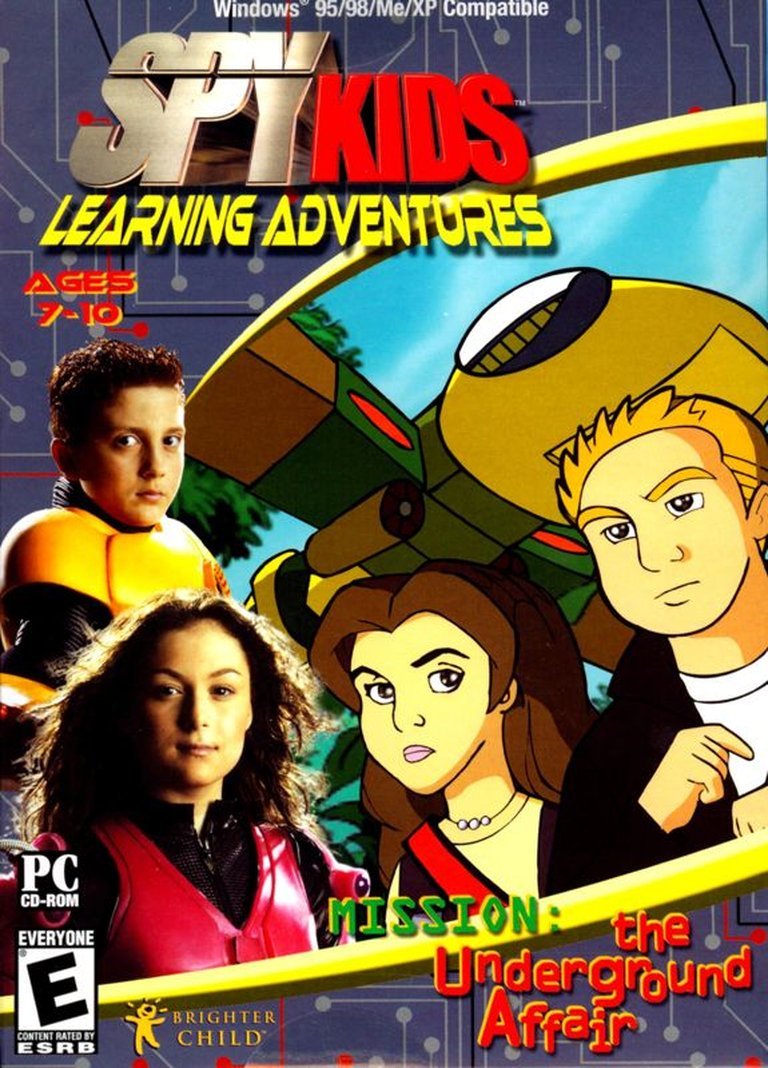- Release Year: 2004
- Platforms: Macintosh, Windows
- Publisher: Brighter Minds Media, Inc., Russobit-M
- Developer: FiniteMonkey, Inc.
- Genre: Educational, logic, Math, Reading, writing
- Perspective: Third-person
- Game Mode: Single-player
- Gameplay: Interactive, Puzzle-solving, Reading, writing
- Setting: espionage, Spy
- Average Score: 70/100

Description
Spy Kids Learning Adventures: Mission: The Underground Affair is a 2004 educational game blending math, logic, and reading challenges within a spy-themed narrative. Players join the Spy Kids to investigate the theft of anti-gravity mineral ore critical to espionage operations. Unfolding through comic book-style visuals, the game requires solving both on-screen puzzles and physical challenges in an accompanying activity book to unravel the mystery. Designed for children, it emphasizes critical thinking and problem-solving through a mix of interactive gameplay and hands-on tasks, set in a vibrant underground world.
Reviews & Reception
mobygames.com (80/100): Critics Average score: 80% (based on 1 ratings)
sockscap64.com (60/100): This Game has no review yet, please come back later…
Spy Kids Learning Adventures: Mission: The Underground Affair: A Deep Dive into a Forgotten Educational Gem
Introduction
In the early 2000s, educational games were often dismissed as mere tools for passive learning, but Spy Kids Learning Adventures: Mission: The Underground Affair (2004) defied that stereotype. Developed by FiniteMonkey, Inc. and published by Brighter Minds Media, this title was part of a series that cleverly blended espionage-themed adventure with educational puzzles. Unlike traditional edutainment games, The Underground Affair integrated interactive and pencil-and-paper puzzles, creating a unique hybrid experience. This review will dissect its development, narrative, gameplay, and lasting impact, arguing that it was ahead of its time in merging entertainment with learning.
Development History & Context
Studio & Vision
FiniteMonkey, Inc., a relatively obscure developer, crafted The Underground Affair as part of a trilogy of Spy Kids Learning Adventures games. The studio’s approach was ambitious: rather than relying solely on digital puzzles, they incorporated an accompanying book, blending physical and digital gameplay. This was a bold move in an era where most educational games were purely digital.
Technological Constraints & Gaming Landscape
Released in 2004, the game was constrained by the hardware of the time—Windows 95/98 compatibility, limited 3D rendering capabilities, and minimal voice acting. Yet, it stood out by using a comic book-style narrative, a visual choice that minimized the need for high-end graphics while maintaining engagement. The early 2000s saw a surge in licensed educational games, but few experimented with mixed-media experiences like The Underground Affair.
Narrative & Thematic Deep Dive
Plot & Characters
The game follows Carmen and Juni Cortez, the titular Spy Kids, as they investigate the theft of anti-gravity mineral ore. The narrative unfolds through static comic book-style panels, with minimal animation but expressive character designs. The dialogue is simple but effective, staying true to the Spy Kids film’s tone.
Themes & Educational Integration
The game’s core theme is problem-solving, with puzzles reinforcing math, logic, and reading skills. The inclusion of a physical book was innovative—players had to solve traditional puzzles (e.g., crosswords, mazes) before unlocking in-game progress. This hybrid approach encouraged active participation, making learning tactile and immersive.
Gameplay Mechanics & Systems
Core Gameplay Loop
Players navigate a 3D environment, solving puzzles to progress. The game alternates between digital and book-based challenges, requiring players to switch between screens. This design was ahead of its time, foreshadowing modern AR and mixed-media gaming.
Combat & Progression
There is no traditional combat; instead, the game focuses on puzzle-solving. Progression is linear, with each solved puzzle unlocking new areas. The UI is straightforward, with clear objectives and minimal distractions.
Innovations & Flaws
The biggest innovation was the book integration, but this also became a limitation—players without the book were locked out of key content. The lack of voice acting beyond key characters also dated the experience.
World-Building, Art & Sound
Visual Direction
The comic book aesthetic was both a strength and a limitation. It allowed for expressive storytelling without high-end rendering, but the static panels felt dated even in 2004. The 3D environments were basic but functional, with bright colors aligning with the Spy Kids brand.
Sound Design
Sound effects and music were minimal, relying on the comic book’s visual storytelling. The voice acting was limited but well-delivered, with standout performances from Lisa Peterson (Carmen) and Kameron Williams (Juni).
Reception & Legacy
Critical & Commercial Reception
The game received a 80% score from Common Sense Media, praising its educational value and unique hybrid approach. However, its niche appeal and reliance on physical media limited its commercial success. It remains a cult favorite among retro gaming and educational game enthusiasts.
Influence on Subsequent Games
The Underground Affair foreshadowed modern trends in mixed-media gaming, influencing titles like Pokémon GO (AR integration) and The Room series (puzzle-heavy narratives). Its legacy lies in proving that educational games could be engaging without sacrificing fun.
Conclusion
Spy Kids Learning Adventures: Mission: The Underground Affair was a pioneering title that blended digital and physical gameplay in a way few games have since replicated. While its reliance on an accompanying book was a double-edged sword, its innovative design and educational depth make it a hidden gem in video game history. It deserves recognition as a forward-thinking experiment that bridged the gap between play and learning.
Final Verdict: A forgotten innovator in educational gaming, The Underground Affair is a must-play for retro and edutainment enthusiasts. Its legacy endures as a testament to creativity in an often-overlooked genre. 8.5/10 – A near-masterpiece of early 2000s edutainment.